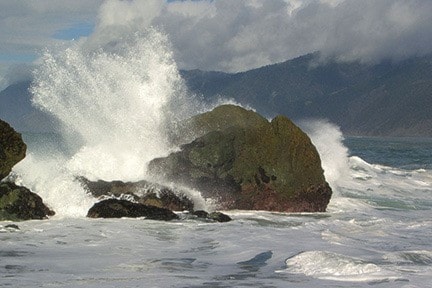So said the Victoria Colonist, Jan. 14, 1896.
Although shipwrecks were almost commonplace off Vancouver Island's treacherous western shore, 120 years ago, the Janet Cowan's ordeal is unequalled. One hundred and eight days out of Cape Town, the Cowan raised Cape Flattery light on Dec. 29. For 48 hours Capt. Thompson vainly tried to stand off under a bitter sou'wester which was steadily beating his lightly-laden, 2,497-ton ship into Barkley Sound.
At 2 a.m., Dec. 31, 1895, she grounded off Carmanah Point. Above the roar of wind, wave and buckling plates, the crew debated their chances as the windjammer threatened to break up just 80 yards from shore. It might as well have been 80 miles — no lifeboat could survive that frenzied surf.
When Able Seaman J. Chamberlain offered to swim to shore with a lifeline, Capt. Thompson shouted, "It's suicide!" But as the young Englishman tore off his clothes, his frightened comrades erupted in cheers then fell silent in the knowledge that their lives rested upon this slight youth's courage. What chance did a boy have against the Pacific Ocean?
Securing the line about his neck, Chamberlain leaped into the sea and vanished in the pounding surf. An hour passed, two hours, as his shipmates anxiously awaited a jerk on the line. But no signal came and they could see nothing in that raging blackness. He was gone.
They couldn't know that Chamberlain was alive, barely, that his lifeline had become entangled on the bottom and, too weak to free it, he'd had to save himself by tearing at the noose with wooden fingers until he finally was able to slip it off and crawl into a hollow log for warmth. In the darkness he didn't realize that he hadn't reached shore but a reef some distance away that would be awash at high tide.
When, four hours after Chamberlain dove over the side, the wind slackened enough to allow volunteers to launch a boat, they found him on his ledge, paralyzed with cold, and they bundled him into dry clothing.
Soon, by means of a breeches-buoy, all of the Cowan's company had reached the ledge whose tenuous sanctuary was painfully apparent. The tide was now coming in and they were yet separated from the beach by a wild surf.
A second hero, this one anonymous, alas, volunteered to swim to shore with another lifeline. This he did successfully and all 29 survivors rode a bosun's chair to safety although Capt. Thompson was almost drowned when his benumbed fingers lost their grip and, as he began to fall, his feet became hooked in the ropes and tipped him upside down in the grasping waves.
Once in the trees they built a fire and several crewmen began searching for signs of habitation. What they did find was the Carmanah Point-Cape Beale telegraph line which led them to a linesman's cabin and crude shelter. The rest of the crew remained by their fire in the trees, trying to keep their feet from being frostbitten. Come morning and a calmer surf, they were jubilant to see the Cowan not only intact but upright, which allowed them to salvage food, canvas and, in the words of the Colonist, "everything moveable".
But not without cost: First Mate Legall broke his leg by falling down a scuttle hole; to get him to their beach camp meant lashing him into the bosun's chair.
Their troubles had just begun. That afternoon, having ransacked the ship, Second Mate John Howell and apprentice seamen Walter Logan and William Steele were returning to shore when their boat was capsized in the surf. There was nothing the others could do to help them and, for days, their bodies were to be seen as they were buffeted about by the surf.
(To be continued)
